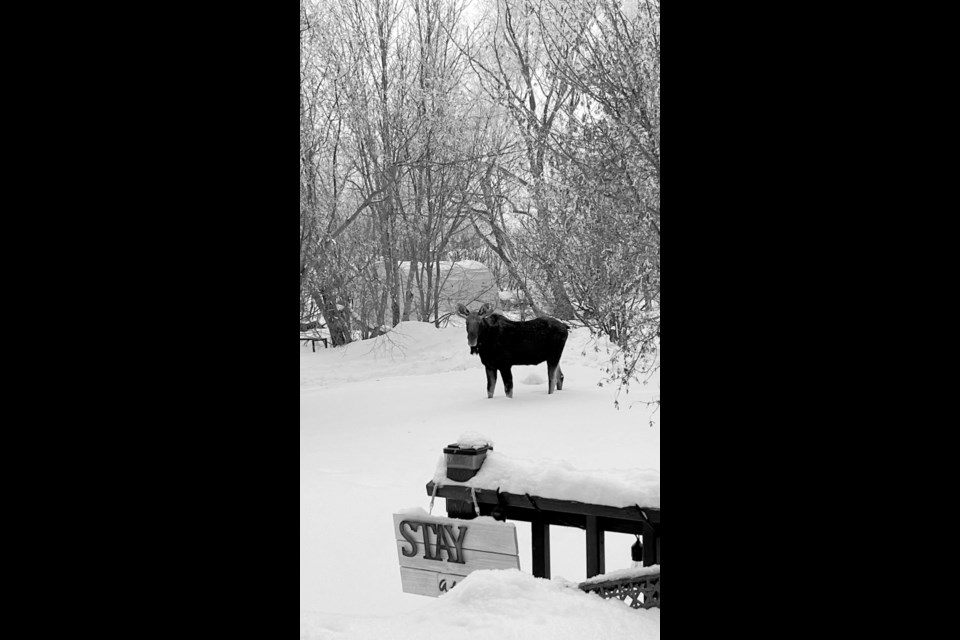LUSELAND — Luseland residents began sharing posts and pictures of moose that were within town limits in the latter part of January, and as far back as mid December.
Ted Glass, conservation officer with Provincial Protective Services, Ministry of Corrections, Policing and Public Safety out of Kindersley provided details to Unity-Wilkie Press-Herald and regarding the occurrences.
Glass says, “Conservation officers … started receiving reports of moose in the community on Dec. 19 from the chief of the Luseland Police. At that time, officers provided advice on how to encourage the animals to move out of town. “
Glass said he visited Luseland Jan. 14 but did not see any moose that day. Jan. 21, officers received reports the moose had returned, and starting Jan. 23, officers from Kindersley and Outlook field offices responsed to the community, working for the next several days to try to move the moose out of town.
Reports over several days identified a total of four moose: a cow, a calf and two bulls. Because moose are large and unpredictable, the importance of emphasizing distance keeping and calling authorities when these occurrences began was relayed. Moose can become aggressive and pose danger to people, pets and property.
Glass offers this advice when encountering moose in rural areas, “Wildlife, including moose, is a natural part of the landscape in Saskatchewan and should always be given space and respect. If you see a moose in the countryside, keep a safe distance and enjoy the opportunity to see wildlife in the wild. If you spot a moose within town or city limits, again keep your distance, and contact your local conservation officer, the Turn in Poachers and Polluters (TIPP) line at-1-800-667-7561, #5555 from a SaskTel cellphone or dial 911. “
Glass advises that the moose situation in Luseland has been resolved. Jan. 24, conservation officers successfully chased a cow, calf and bull moose from town. While the cow and calf returned immediately, hiding in a nearby tree belt, the large bull stayed away.
“On Jan. 25, officers were able to chase a second bull moose out of the community. Over the next two days, the cow and calf were sighted in various locations around town, chasing dogs and still unwilling to leave. Jan. 26, officers made the difficult decision to euthanize the cow and calf with the co-operation of the town of Luseland and local police,” Glass reports.
The moose saga however was not over, as Jan. 28, officers received reports that one bull moose had returned. The next day, after considering available options, officers determined that, in the interests of public safety, it was best to humanely euthanize the animal.
Glass reports that all of the meat was donated to members of the local First Nations community.
“When dealing with problem wildlife, conservation officers assess each situation and choose the best option, with public safety as the most important consideration. Immobilizing and relocating a large animal, like a moose, is a difficult and complex task, and, unfortunately, is not always an option.”
Sometimes in the best-case scenario, animals will move along on their own. Depending on the location and circumstances, officers may try to encourage an animal to move out of town before considering other options.
“Officers have a high rate of success but sometimes the outcome for the animal is not the one we hope for,” says Glass.
In a similar time-frame, a herd of deer was being shown in social media posts on the courthouse grounds.
Glass said, “It’s fairly common for moose and other wildlife to move into populated areas seeking available food and cover during the winter months. Trees and shrubs in communities offer good browsing opportunities. Other attractants, like pet food, bird feeders or unsecured garbage, can also draw wildlife in to where people live.
Well-meaning individuals sometimes leave feed out for wildlife in winter, but this can do more harm than good and is discouraged. Feeding dangerous predators such as wolves, coyotes or bears is illegal.
In particular, deer can be harmed by carbohydrate-rich food sources, such as grain or hay, during the winter and they can die from a process known as rumen acidosis or bloat.
Supplemental feeding can also draw animals in and away from good winter cover, causing public safety issues and increased predation and disease transmission.




